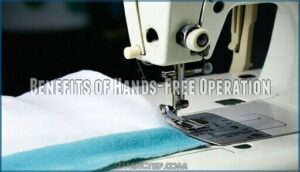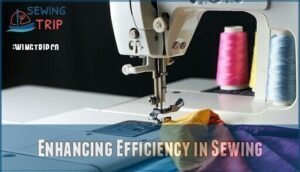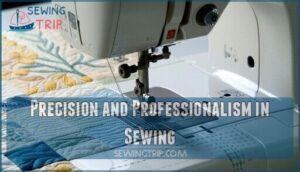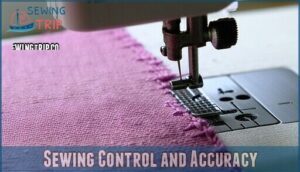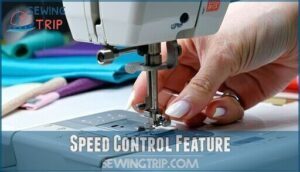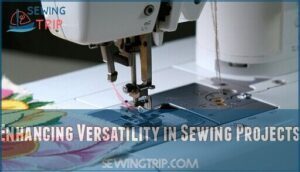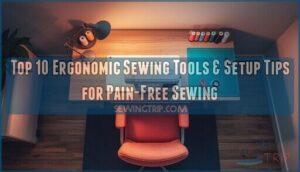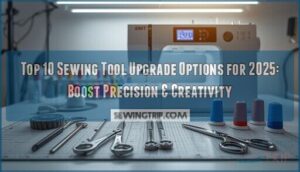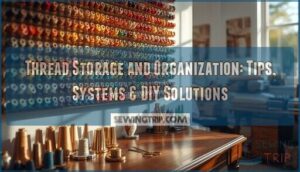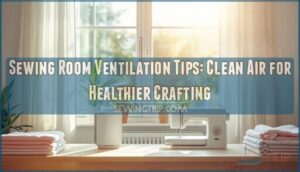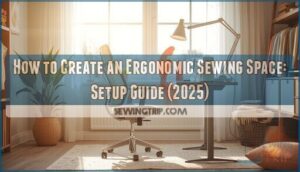This site is supported by our readers. We may earn a commission, at no cost to you, if you purchase through links.
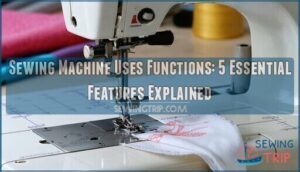 Modern sewing machines transform your crafting with powerful sewing machine uses functions that boost efficiency and precision. You’ll find knee lift controls for hands-free presser foot operation, automatic thread cutting that eliminates manual snipping, and dual-feed systems preventing fabric puckering.
Modern sewing machines transform your crafting with powerful sewing machine uses functions that boost efficiency and precision. You’ll find knee lift controls for hands-free presser foot operation, automatic thread cutting that eliminates manual snipping, and dual-feed systems preventing fabric puckering.
Speed control lets you adjust stitching pace for different materials, while needle up/down positioning gives you precise stitch control. These features work together like a well-oiled machine, reducing hand strain and delivering professional results across various projects.
Each function has a specific purpose that can make or break your sewing experience.
Table Of Contents
Key Takeaways
- You’ll boost efficiency by 30% with hands-free features like knee lift controls that let you raise the presser foot while keeping both hands on your fabric for better manipulation and positioning.
- You can eliminate constant interruptions with automatic thread cutting that slices both needle and bobbin threads instantly, keeping your workflow smooth during complex projects without manual snipping.
- You’ll achieve professional results with dual-feed systems that synchronize fabric layers through up to sixteen cotton layers, preventing puckers and shifts that ruin careful piecing work.
- You can match your machine’s pace to any project with speed control features that let you crawl through thick materials or cruise through lightweight fabrics while maintaining consistent stitch quality.
Must-Have Features for Hands-Free Operation
When you’re working with thick fabrics or multiple layers, you’ll want hands-free features that keep your project moving smoothly.
The knee lift feature lets you raise the presser foot without stopping your work, which means you can guide fabric with both hands while maintaining control.
Knee Lift Feature
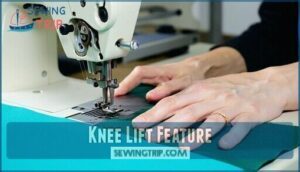
The knee lift transforms your sewing experience by letting you control the presser foot with your knee. This hands-free control keeps both hands free for fabric manipulation, especially important during quilting applications. You’ll press the lever proportionally—light pressure lifts slightly, firm pressure raises fully.
The ergonomic benefits are immediate: no more stopping mid-seam to fumble with controls. Modern sewing technology integrates this feature seamlessly, boosting efficiency by 30% in complex projects.
For knee lift alternatives, some machines offer foot pedal variations, but nothing beats true handsfree operation. The Bernina Free Hand System provides precise control over the presser foot using the knee. This sewing machine function revolutionizes how you approach detailed work.
Benefits of Hands-Free Operation
Hands-free operation transforms your sewing experience by freeing up your hands for better fabric control. This hands-free operation feature delivers enhanced productivity while reducing fatigue during long projects. Your sewing machine functions become more straightforward when you can lift the presser foot with your knee instead of stopping to use your hands.
The hands-free operation feature offers three key advantages:
- Enhanced Productivity – Keep both hands on your fabric while adjusting presser foot pressure
- Improved Control – Maintain consistent stitching through better fabric guidance and positioning
- Safer Sewing – Reduce hand strain and maintain proper posture during extended sessions
This enhancing sewing efficiency approach helps you achieve better sewing control accuracy on every project.
Enhancing Efficiency in Sewing
When you’re working on multiple projects or facing tight deadlines, efficiency becomes your best friend in the sewing room.
Smart sewing machine features can cut your project time in half while reducing the repetitive tasks that slow you down.
The Advantage of a Thread Cutter
Imagine this: you’re deep into a complex quilting project when you realize you’ve been stopping every few stitches to snip threads with scissors. An automatic cutting feature eliminates this tedious interruption. Modern sewing machines with built-in thread cutters slice both needle and bobbin threads instantly with a simple button press or foot pedal activation.
Modern sewing machines with automatic thread cutters eliminate the constant interruption of manually snipping threads during complex projects
This sewing machine function delivers significant time savings during extended projects, keeping your hands free for fabric positioning and control. The clean finish prevents frayed thread ends that can snag on future work. Enhanced workflow means fewer interruptions and smoother transitions between seam segments.
You’ll notice reduced thread waste since the cutter trims precisely at the fabric edge. Thread cutting becomes straightforward, transforming how you approach complex garments and detailed work. Your sewing machine operates more efficiently when every cut is consistent and clean.
Improving Speed and Efficiency
Optimizing workflow becomes second nature when you master your sewing machine’s speed-enhancing features. Modern machines transform routine sewing tasks through smart automation options and ergonomic design elements that work together seamlessly.
Here’s how to get the most out of your efficiency:
- Speed control lets you adjust stitching pace for different fabric weights and complex seams
- Automatic thread cutting eliminates manual snipping, keeping your hands positioned on the fabric
- Programmable stitch patterns reduce setup time between different sewing machine functions
- Proper maintenance practices keep up consistent performance during long quilting or garment sessions
Training techniques like practicing consistent pedal pressure will help you maintain a steady rhythm. Remember, efficiency isn’t just about going fast—it’s about reducing interruptions and maintaining quality throughout your project.
Precision and Professionalism in Sewing
You’ll achieve professional results when your sewing machine’s dual-feed system moves fabric layers evenly through complex quilting projects.
These precision features eliminate puckering and shifting that can ruin hours of careful work.
Dual-Feed Options for Precise Quilting
When quilting, precision matters most, and dual-feed options become your secret weapon. This integrated dual feed system synchronizes top and bottom fabric layers, preventing fabric shift that ruins careful piecing work.
Unlike basic walking foot benefits, dual-feed mechanisms handle up to sixteen cotton layers without misalignment. Your quilting sewing machine maintains even fabric feed through complex seams, eliminating puckers and waves.
For precise quilting projects requiring exact quarter-inch seams, dual-feed options make sure consistent fabric handling from start to finish. You’ll spend less time correcting mistakes and more time creating beautiful quilts.
The Pfaff Passport 2.0 sewing machine offers an integrated dual feed system for enhanced fabric control.
Achieving a Professional Finish
When you master precision and professionalism in your sewing work, you’ll notice the difference immediately. Professional finish sewing requires attention to detail and specialized techniques that transform ordinary projects into polished masterpieces. Here’s how to achieve stitch quality that rivals store-bought items:
- Seam Finishes – Use French seams or serged edges to prevent fraying and create clean interior lines
- Pressing Techniques – Press seams flat before crossing with another seam for crisp intersections
- Topstitching Tips – Maintain consistent 1/8-inch spacing from edges using your presser foot as a guide
- Understitching Benefits – Secure facings and linings to prevent rolling, creating sharp collar and neckline edges
Blind hems and stitch accuracy separate amateur work from professional results.
Sewing Control and Accuracy
When you’re working on detailed projects, you need your machine to stop exactly where you want it. The needle up/down feature gives you complete control over fabric positioning, preventing those frustrating shifts that can ruin precise seams.
The Needle Up/Down Feature
Many sewers overlook how the Needle Up/Down Feature transforms their Sewing Technology experience. This Sewing Machine function gives you Precise Stitch Control by positioning the needle exactly where you need it. When you stop stitching, the needle stays down in your fabric, creating a perfect Pivot Point Sewing anchor.
You can rotate your material smoothly without losing Seam Continuity or creating puckered corners. This Fabric Manipulation control prevents skipped stitches and maintains professional results. The feature works automatically on modern machines, letting you focus on technique rather than needle position.
It’s essential for quilting, appliqué work, and detailed garment construction where accuracy matters most.
Enhancing Sewing Control and Accuracy
The needle up/down feature transforms your sewing control and accuracy by letting you decide where the needle stops. When you set it to stay down in the fabric, you can pivot corners smoothly without losing your place. This prevents fabric shifting and maintains perfect seam allowances.
Combined with proper tension adjustment and stitch length settings, you’ll achieve professional-looking results every time. The feature works especially well with seam guides and speed control for precision work.
Your fabric feeding stays consistent, and needle positioning becomes second nature. It’s like having a steady hand that never wavers, giving you confidence for detailed projects.
Versatility for Various Sewing Projects
You’ll find that speed control transforms your sewing machine into a tool that’s suitable for any project you tackle. Whether you’re carefully stitching delicate silk or powering through heavy denim, adjustable speed settings let you match your machine’s pace to the material and technique at hand.
Speed Control Feature
Beyond controlling needle positioning, the speed control feature transforms how you handle different sewing projects. Variable speed adjustment lets you match your machine’s pace to each fabric’s needs—crawling through thick leather or cruising through cotton.
Modern sewing machines offer motor power settings that maintain stitch consistency regardless of your chosen speed. This means you won’t sacrifice quality for control. Here’s how speed control enhances your sewing machine uses:
- Beginner Control: Start slowly on new techniques, building confidence before increasing pace
- Project Complexity: Handle intricate details at low speeds, then switch to high-speed straight seams
- Fabric Adaptation: Dense materials need slower speeds while lightweight fabrics handle faster stitching
- Precision Work: Detailed embroidery and appliqué require deliberate, controlled movements
The speed control feature practically gives you a dimmer switch for your sewing machine. You can fine-tune the motor’s output to match your skill level and project demands. Whether you’re tackling your first buttonhole or racing through a quilt binding, this feature is great for your requirements, making every project more manageable and enjoyable.
Enhancing Versatility in Sewing Projects
When tackling different sewing projects, speed control transforms your machine into a true multitasker. This feature lets you slow down for delicate fabric selection like silk or lace, then ramp up speed for sturdy denim or canvas.
You’ll handle pattern adaptations smoothly, switching between intricate decorative stitches and basic seams without missing a beat. Accessory integration becomes straightforward as you adjust speed for buttonholes, zippers, or bias tape.
Project complexity doesn’t intimidate when you control the pace—from quilting’s precise stitch variations to garment construction’s varying demands, your sewing machine uses adapt perfectly to each challenge.
Frequently Asked Questions (FAQs)
What maintenance do sewing machines require regularly?
You’ll clean and oil your machine weekly if you sew daily, or monthly for occasional use. Clean after every 3-4 bobbin changes or major project.
How do different stitch types affect fabric?
Different stitch types create unique effects on fabric. Straight stitches provide strong seams, zigzag stitches stretch with knits, while decorative stitches add texture and visual interest to your projects.
Which fabrics work best with home machines?
You’ll find cotton, polyester blends, and lightweight fabrics work beautifully with home machines. Avoid thick leather, heavy canvas, or multiple denim layers—they’ll strain your needle and motor.
What safety precautions should beginners follow while sewing?
Safety starts with needle awareness and proper posture. Keep fingers away from the needle path.
Turn off power when threading or changing feet.
Use sharp needles for clean stitches and fewer accidents.
How do you troubleshoot common threading problems?
Check your upper thread tension first. Rethread completely, ensuring thread passes through all guides. Verify bobbin’s wound correctly and seated properly. Adjust needle position if stitches look uneven.
Conclusion
Think of these sewing machine uses functions as your creative toolkit’s Swiss Army knife. Each feature solves specific challenges you’ll face during projects.
The knee lift keeps your hands free for fabric positioning. Thread cutters eliminate interruptions mid-seam. Dual-feed prevents fabric shifting on delicate materials. Needle positioning gives you pinpoint control for corners and curves.
Speed control is suitable for different fabrics and skill levels. Master these functions and you’ll transform from struggling beginner to confident sewist.

